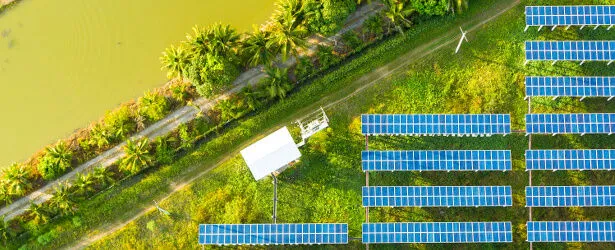HARALD ÖVERHOLM Yes, absolutely, and I think the first question as to what's happening on the actual solar production side, sometimes I find myself giving the dull answer to that question, which is that a lot of things are happening but perhaps nothing revolutionary. Really what we benefit from as an industry is just to keep shaving the production cost of solar, and we do that in a myriad of ways in parallel, nothing revolutionary again but just the combined effect of everything from the panels.
There is this constant incremental innovation going on on the panels side and you have probably seen things like bifacial panels that can produce electricity also from the diffused insulation that comes from the back of the panel basically. It's just one of many examples of how the existing crystalline silicon technology is becoming a little bit more efficient, a little bit more cost-efficient every day, and it contributes to the end goal which is the lower cost of electricity.
Now, because of how the solar market is working globally, where typically there's an ecosystem around a finalized solar installation, someone is financing it, someone is insuring it, someone is providing warranties, someone has installed it, etc, it's really an ecosystem that has to work together. And I think because of that we're unlikely to see much traction in new panel technologies.
So, the crystalline silicon technology that we've been using for such a long time now and it's really the first PV technology ever to emerge, the whole ecosystem has adapted to work on that technology. And if we can just make a projection, it seems very unlikely that that's going to change, but instead what you're going to see is a lot of ways in which we keep shaving the production cost. And as far as we can tell the production cost keeps going down by about 10% every year from these learning costs.
So, that was the first question about the existing generation technology. The second question on storage and what's happening in that market, I think just speaking from our point of view as someone in the market who is looking to deploy storage, that's really something we want to do, actively looking at situations. What is the bottleneck? Why aren't we doing that even today?
The bottleneck is squarely I think in terms of the digital automation of how you create value from storage. So, it's not the actual digital side of just running the battery, which is fairly straightforward and it's out there, but more you want the battery to create financial value in a predictable way, because otherwise you can't build a business model around it and you can't finance it, etc.
In order to do that, you have to automate the battery dispatch, so that it really works across a number of situations and that it can create several different financial values on top of each other. So, it probably needs to create some kind of value from frequency regulation and another kind of value from time of use, energy time of use, load shifting, etc. And there's no way you can have an operator that switches on and off the battery. That just doesn't work. So, it does need to be automated.
What we see today in Europe is that when storage is deployed, typically people have customized the software needed for that one single deployment which is obviously what you need to do. But in order to do something more than just pilots, in order to do something repeatable, we will need to see that software get much more adaptable and much more of a platform architecture. That's what we're seeing in the US, a number of very sophisticated companies in the US developing that. But to a fairly large extent you need to adapt to local circumstances and those US companies have not done this for Europe yet.
I think in Europe this is really the bottleneck and in the US that's perhaps not the bottleneck anymore. So, you actually see large scale repeatable storage deployment now in parts of the US and that's definitely where I would like to see Europe in just two or three years from now.


